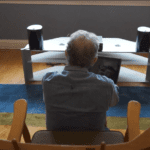Whether it’s the slow speed of cassette tapes, the high compression of MP3 files or the excruciating sound of cheap earbuds, portable music has not often been associated with quality. It seems to me that much of the audio industry believes that we either don’t notice, or don’t care.
Thankfully Sony does, and their new line of Hi-Res labelled audio products – players, decoders, speakers and headphones provides a higher quality listening experience. They want you to think of Hi-Res as HD-TV for your ears, but I kind of suspect H-Res audio isn’t quite as easy a sell as Hi-Def TV sets.

Sony sent over a Walkman and headphones to try out. These are entry level components.
The Walkman (NWZ-A17 $300) is a digital media player that’s easily mistaken for a phone. Small, light, stylish, 64GB storage and a micro SD slot. You can store and listen to music, but also view pictures and play videos. It has an FM radio tuner. It has Bluetooth to transmit audio to speakers wirelessly. Sleep timer and alarm are among the options.
All of those things work as advertised – the menu and navigation will seem familiar to just about everyone. A navigation keypad and a couple of extra buttons on the front, volume and hold on the side. You recharge it and transfer files to it using USB. All pretty standard stuff.
And it plays all the standard compressed audio file types – MP3, WMA, AAC. None of those features distinguish this player. What sets the NWZ-A17 apart is support for Hi-Res audio files, which go far beyond the quality offered by standard compressed files. In order to qualify as Hi-Res, files must be lossless – which allows for compression only to the extent that all the original information can be recovered.
The CD sampling standard captures 16 samples 44,100 times per second, so anything north of that is Hi-Res. This player supports rates up to 24 samples at 192kHz. In theory, this larger data stream can capture, store and play more detail.
The loan coincided with a holiday special from Linn Records, the “24 bits of Christmas” – a selection of free sample tracks from their 24-bit studio master recordings. The selections ranged from Classical to Jazz, with some Alt-pop. Listening to these tracks, over the headphones (more in a minute), or through the analog output to my home stereo system, and in my car, proved to be an interesting experience. We listened.
These tracks grabbed and held our attention in a way that seemed unusual. Our usual is to listen a bit, and then to start a conversation. But we listened, which was a little bit of a revelation. Yes, most of the music was new to us, the selections were selected to make an impact, the engineers at Linn clearly take great care to produce high quality recordings from microphone placement to high resolution sampling. All of those are factors too. However, I can’t deny that the quality affected our attention span. The detail revealed nuance, bringing us closer to the music, connecting more directly than we’ve become used to. I hadn’t expected that.
I had expected clarity, I’d expected definition, I’d expected to hear more harmonics – and those expectations were met. Specifically, the highs are clear and pure, not brittle or edgy. Vocals stand out with a very distinct presence. I’m always particularly attentive to piano, and the piano pieces in the Linn selections were among the clearest, cleanest I’ve heard, capturing both quiet passages and loud percussive sections with precision.
The ultra-quiet sound space, and the dimension that it reveals in the performance, positioning the artists and the instruments, provides an intimacy, a sense of immediacy that resets the bar for music listening. And the large dynamic range, which frequently had us adjusting the volume as we listened while driving, offers a series of gradations that bring new clarity to quiet sounds and much more power to loud ones.
The MDR-1A stereo headphones are the large over-the-ear type. They exude quality and style. The cord is detachable.They fit very comfortably, with soft pads and the right amount of pressure from the head band to hold them in place without discomfort. I’ve tried and used lots of headphones, but in general, they’re not my preferred listening environment. So, like the person who hates apple pie but judges this to be the best apple pie, my experience needs to be taken with a grain of salt.
I found my preferred audition tracks sounded as good as I’ve heard them, with here and there a detail I thought I’d not heard before, or experienced in a new way. The freight train drive of Angelique Kidjo’s Gimme Shelter is a good test for both volume (I like this one LOUD), bass – with a smooth bass guitar line and a tight rhythm section both accurately rendered, Angelique and Joss Stone’s powerful vocals are clearly distinguished and the cymbals are nicely bright. Even at 30 (the maximum volume setting), the sound in the phones remains clear and undistorted. Impressive. (Details and more sample tracks are listed below)
It’s tempting to compare this experience to the live performances we attend at Toronto’s great music spaces – Koerner Hall, Massey Hall, Roy Thompson Hall. We’ve been there and heard that – and honestly the experience offered here is not equivalent. It’s different, in the same way that watching hockey on an HDTV is different from attending a game at the Air Canada Centre. It’s a distinct experience, highly pleasurable, but not comparable.
I loved the experience of listening with these components, together and separately. My expectations were high, and were met.
The issue with Hi-Res is not quality – that’s achieved as expected, Sony’s reputation in this space is well established. The issue is content. Linn, and their small cohort of high-end but marginal music producers with artists far from the mainstream, will only ever represent a tiny portion of the music that appeals to me and you. And sadly, the albums you love, the artists you prefer are, for the most part, not available in Hi-Res formats. Not even from Sony. They provide a list of Hi-Res web sites to purchase tracks, but.
And along with the kit, Sony included a coupon to download two albums from ProStudioMasters, an online Hi-Res audio site. Like other hi-res audio sites I’ve browsed in the past, the selection is limited, and even more limited if you want either DSD or 192/24 files. I did find Emilie Claire Barlow’s Live in Tokyo – a superb quality recording by a very pure voice. I chose DSD, the highest quality, only to find that wasn’t supported by the player. Dopey me.
And then it’s like a video store late on Saturday night – there’s nothing left, so you settle for something you’re hoping will live up to your expectations. Well, maybe the Getz/Gilberto collaboration album isn’t that much of a gamble, but after at least 30 minutes of searching and browsing, it’s the best I could do. And while I appreciate that extra care was taken to convert/sample this old recording to digital, it was (at best) recorded on tape. Since there’s no tape hiss, it’s been processed, so goodness knows what I’m actually listening to. I’m not complaining, just saying.
Sony has been here before, with the SA-CD format, an enhanced audio standard that is less popular and less available than vinyl. (Oh, and elcassett – an attempt to bring quality to those terrible compact cassette tapes.) The DSD recording format, supported by most of Sony’s Hi-Res line was first used in SA-CDs. Even if you have some of those high quality SA-CD recordings, getting them from those discs onto this player involves challenges in hardware and software that is beyond obscure.
Unless there’s an unexpected infestation of Hi-Res tracks, you’ll probably be listening to those lo-res mp3 files for a while yet. Sony gets that, and provides a technology they call DSEE to extrapolate information from those files to create a larger dynamic range. The improvement is minimally audible, but these components already make everything sound better.
While both the recordings and the players show the value of Hi-Res, we are far away from any kind of virtuous circle where the selection of titles drives demand for players and the selection of players drives demand. I wish that my enthusiasm for Hi-Res audio had some mainstream resonance, but I’m afraid it doesn’t.
So here’s the challenge for Sony. I love that you’re getting behind DSD again, in a smarter file-based format. And all of this hardware is amazing – for those of us who can still sit quietly and listen to music – this player, these headphones offer an experience that puts us front and centre in a near-ideal virtual listening space. But you need to mobilize your content engine – release all new recordings in one or more Hi-Res formats. Lower the price and get us hooked. Get the most popular catalog titles up in Hi-Res. Upgrade your Music Unlimited streaming site to support Hi-Res. Incidentally, I’ve heard your issues about bandwidth – but honestly, it’s less than Netflix.
For most of us, music listening has been relegated to a low-order multi-tasking event. Maybe it’s the low quality, so we’re not getting much satisfaction or enjoyment from it – not the way our parents who hand built DynaKit components from Heathkit used to. Hi-Res could change that – there’s a lot of great music out there. I’m wishing Sony well, but.
Anyway, if you’ve read this far, here are a few of the tracks that I use to listen to audio/stereo/home theatre equipment. And if you’re interested, just listen – take a few of your favourite discs, position a chair in the perfect listening spot, bring your favourite beverage, turn it up to concert hall level and listen.
Simone Dinnerstein J.S. Bach Goldberg Variations (Telarc CD 80692) Compressed files really don’t handle solo piano well – and the transition from the aria to the first variation is particularly ear-opening. Set the level so that the aria sounds like a piano in the room and wait for the fortissimo attack of the first variation.
Antonio Forcione and Sabina Sciubba Meet Me in London (naim cd021 – sadly the only recording they made together). For a well-recorded voice play Caruso, for a terrific percussion and guitar track, play Brasilico. For a reference to see how good these tracks can sound, go to Bay Bloor and listen on the totem forest speakers. Sabina’s voice literally comes out of the speakers on the former, the snap of the drums is tight and powerful on the latter. Listening to Caruso on a high end playback system has brought tears to my eyes. This is now available in 192/24.
Emilie-Claire Barlow Sings (RT CD0001) Pipoca creates an incredible blend between Emilie-Claire’s clean and pure voice and the band.
Lyle Lovett Joshua Judges Ruth (Curb MCAD 10475) The depth and breadth of the soundstage of the various players and singers in Church is the best cut I know for judging stereo placement, left to right and back to front.
Angelique Kidjo Djin Djin (razorandtie 79301822967-2) Although no recording can do justice to the power that Kidjo displays live, Gimme Shelter (with Joss Stone) does a pretty good job of raising the roof while opening your heart to the emotional power of this tune. Great bass, killer horns and searing vocals to challenge any system’s clarity when confronted with a wide-spectrum wall of sound.




